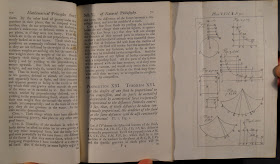Isaac Newton's Principia is arguably one of the most important books in the history of science. Originally written in Latin for a learned audience, it was translated into English in 1729. Our copy of The Mathematical Principles of Natural Philosophy (London: Benjamin Motte, 1729) has had a long and varied life. It has four different owner marks (besides Dartmouth's bookplate) and once was part of the "Cambrian Cocoa Room Library," a 19th-century subscription lending library.
The book's content was revolutionary, but on a much smaller scale, the book offers a clever innovation in design. If you have ever struggled with a mathematics book that depended on diagrams, you'll understand. Each diagram of the Principia is tipped in as a separate folding plate. When unfolded, the portion of the plate that matches the book's text block is blank, but the diagram extends out and can be followed as you read. As a result, you don't have to flip back and forth between the discussion and the plate because the illustration is visible outside of the text.
To see the book, ask for Rare QA803.A45 1729.


No comments:
Post a Comment